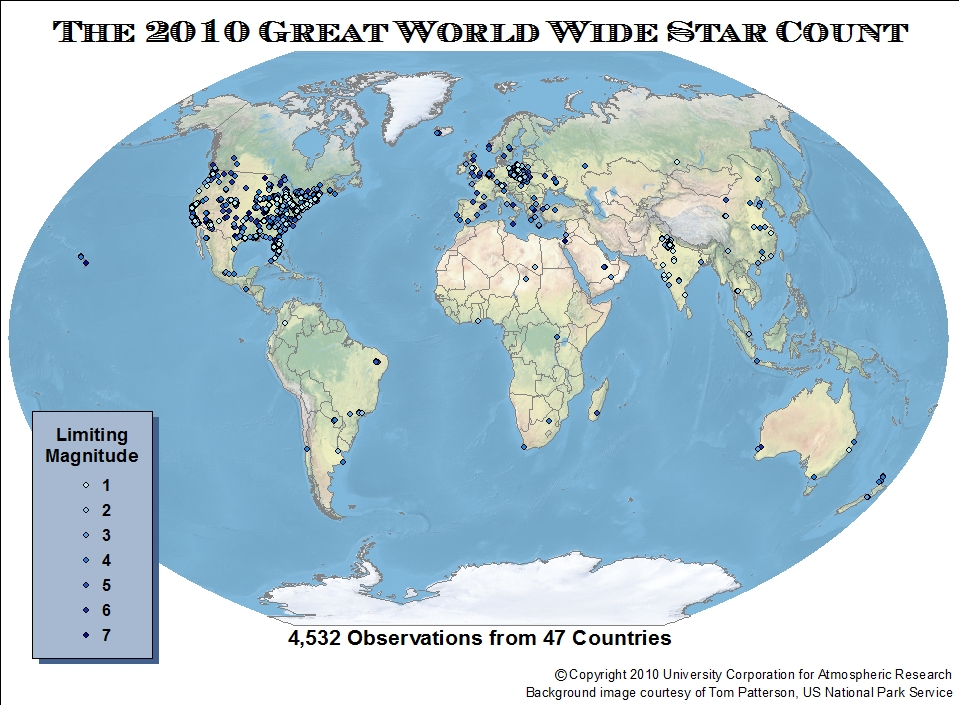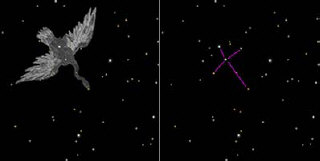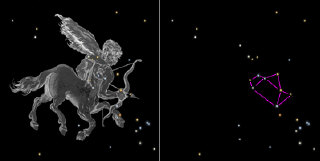Great World Wide Star Count
| 这个页面或段落的内容需要扩展 由于信息不足等原因,这个页面或段落只提供了较少的内容,请了解相关内容的Wiki用户协助扩展。
用户 cuihao 给出的意见是:烂尾 。 欢迎其他用户前往讨论:Great World Wide Star Count发表见解。 欢迎无wiki账号的用户到论坛的Wiki系统讨论区(注册)参与讨论。 |
Great World Wide Star Count 是一项邀请大众参与的国际科学项目。首次活动从2007年10月1日到10月15日,半个月时间内,志愿者根据活动指南(有中文版)中的指示步骤观察天上的星座,根据示意图进行亮度对比,之后在线递交报告。最后根据全球数以千计的观察者报告绘制一份光污染地图。
2008年第二次年度活动从10月20日到11月3日。
2009年第三次年度活动从10月9日到23日。
参与步骤
(完整教程下载:官方
我需要什么?
- 钢笔或铅笔。
- 红灯或“夜视”闪光灯。
- 全球定位系统,英特网,或地图。
- 一份打印好的行动指南及空白报告表。
我该怎么做“夜视”闪光灯?
- 用红色玻璃纸或棕色纸袋将闪光灯的镜头遮住。
- 用胶带或橡皮筋将它固定。
我什么时候观测?
- 项目指定时段内的任何一个(或多个)晚上。
- 大约在日落后的一个小时(一般是当地时间晚上七点与九点之间)。
我观测什么?
- 寻找你的星座:
- 如果你住在北半球,你会看到天鹅座,像一只大天鹅,其中包括了北天星座。
- 如果你住在南半球,你会看到射手座,像一个弓箭手,其中包括了茶壶一样排列的恒星群。
- 将你看到的夜空和下面的亮度表相对比。
我在哪里观测?
- 在任何一个你可以定经纬度的地方。
- 可选项目:在相距至少一公里的另一个地点报告另一次观测结果。
别忘了!
给你的眼睛大约十五分钟去适应夜空的黑暗。
注意安全!
- 夜晚在户外要准确判断,穿足衣服。
- 小孩要有大人照看。
地理坐标
After determining which constellation to observe, you will match your nighttime sky with one of the magnitude charts of that constellation. This will determine the magnitude of the faintest stars that you can see at your location. (Magnitude Charts are included in the printable Activity Guide.) You might see more stars or fewer in different locations, depending on how much light pollution is in your area.
Northern Hemisphere (Cygnus) Magnitude Charts - Practice with a fun quiz!
Southern Hemisphere (Sagittarius) Magnitude Charts - Practice with a fun quiz!
Astronomers use a special term to talk about the brightness of stars. The term is "magnitude." The magnitude scale was invented by the ancient Greeks around 150 B.C. The Greeks put the stars they could see into six groups. They put the brightest stars into group 1, and called them magnitude 1 stars. Stars that they could barely see were put into group 6. So, in the magnitude scale, bright stars have lower numbers. Read more about the magnitude of stars at Windows to the Universe.
汇报结果
观测完成,你可以汇报结果:http://www.windows2universe.org/citizen_science/starcount/report.html
项目阶段结果
2007
2007年的活动中项目收集到了来自64个国家的6,624个观察报告。

详细的结果图片和资料数据请访问这里。
2008

2009

2010

2011


